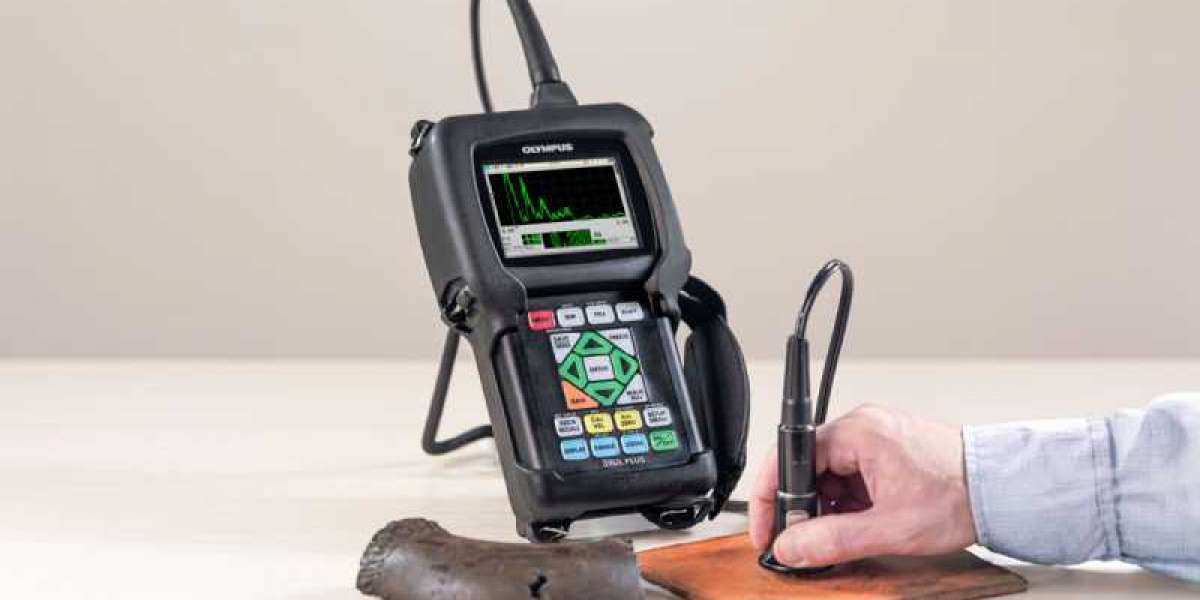Corrosion is a silent but serious problem affecting industries worldwide. From pipelines and bridges to ships and storage tanks, corrosion weakens structures, leading to safety hazards, costly repairs, and potential failures. This is why early detection is critical—and ultrasonic testing (UT) is one of the most effective methods for spotting corrosion before it becomes a major issue.
One of the most reliable tools for corrosion detection is an ultrasonic thickness gauge. It helps inspectors accurately measure material thickness and detect thinning caused by corrosion. If you’re looking for a high-quality ultrasonic thickness gauge, check out this advanced option for precise and non-destructive measurements.
What Is Ultrasonic Testing?
Ultrasonic testing is a non-destructive testing (NDT) method that uses high-frequency sound waves to measure material thickness and detect flaws. The sound waves penetrate the material and reflect back, providing information about the condition of the internal structure.
This technique is widely used across oil and gas, marine, aerospace, construction, and manufacturing industries to assess corrosion, cracks, and structural defects.
How Corrosion Affects Structures and Equipment
Corrosion is a natural process where metals deteriorate due to environmental exposure, such as moisture, chemicals, and oxygen. Over time, corrosion can lead to:
✔ Material thinning – Reducing the strength of the structure
✔ Leaks and failures – Compromising safety in pipelines and tanks
✔ Expensive repairs – Leading to downtime and costly replacements
✔ Structural collapses – Endangering lives and causing catastrophic damage
Without proper inspection, corrosion can go undetected until it’s too late, resulting in severe consequences.
Why Ultrasonic Testing Is the Best Method for Corrosion Detection
There are several techniques for corrosion detection, including visual inspections, radiographic testing, and magnetic particle inspection. However, ultrasonic testing stands out as the most effective and reliable method. Here’s why:
1. Non-Destructive and Safe
Unlike traditional methods that may require cutting or dismantling parts, ultrasonic testing is completely non-invasive. It allows inspectors to examine materials without damaging them, making it ideal for critical structures like bridges, aircraft, and industrial pipelines.
2. High Accuracy and Precision
An ultrasonic thickness gauge can detect even the smallest changes in material thickness, allowing for early identification of corrosion. This level of accuracy ensures that proactive maintenance can be carried out before problems escalate.
3. Detects Corrosion in Hard-to-Reach Areas
Corrosion often occurs in internal or hidden areas where visual inspections fail. UT can penetrate coatings, paint, and insulation, making it perfect for detecting hidden corrosion in pipes, tanks, and offshore structures.
4. Cost-Effective Preventative Maintenance
By identifying corrosion early, ultrasonic testing prevents costly breakdowns and emergency repairs. Industries can plan maintenance schedules efficiently, reducing downtime and saving money.
5. Works on a Variety of Materials
Ultrasonic testing isn’t limited to just metals. It works effectively on plastics, composites, and ceramics, making it a versatile solution across multiple industries.
6. Provides Digital and Recorded Data
Modern ultrasonic thickness gauges come with data logging and digital recording features, allowing inspectors to track corrosion trends over time. This data is invaluable for predictive maintenance and compliance reporting.
Industries That Rely on Ultrasonic Testing for Corrosion Detection
Several industries depend on UT for ensuring structural integrity and safety. Here’s where it plays a crucial role:
1. Oil and Gas Industry
Pipelines, refineries, and offshore rigs are highly susceptible to corrosion due to exposure to moisture, chemicals, and extreme conditions. UT helps detect thinning walls and potential leaks, preventing catastrophic failures.
2. Marine and Shipbuilding
Saltwater is highly corrosive, affecting ship hulls, storage tanks, and offshore platforms. Ultrasonic testing ensures that marine structures remain seaworthy and safe.
3. Aerospace and Aviation
Aircraft structures, including wings, fuselage, and landing gear, undergo constant stress and environmental exposure. UT helps detect corrosion and ensures flight safety.
4. Infrastructure and Construction
Bridges, tunnels, and high-rise buildings rely on steel and concrete reinforcements that can degrade over time. Regular UT inspections help maintain their long-term durability and safety.
5. Power Plants and Manufacturing
Boilers, turbines, and industrial machinery must be corrosion-free to function efficiently. UT plays a key role in preventing mechanical failures.
Types of Ultrasonic Testing Used for Corrosion Detection
1. Ultrasonic Thickness Measurement (UTM)
This method measures material thickness and detects areas where corrosion has thinned the structure. It is widely used in pipelines, tanks, and pressure vessels.
2. Time-of-Flight Diffraction (ToFD)
ToFD is an advanced technique that provides detailed imaging of corroded areas and internal defects. It is commonly used in critical infrastructure inspections.
3. Phased Array Ultrasonic Testing (PAUT)
PAUT uses multiple ultrasonic beams to scan a large surface area and detect corrosion with high precision. This method is ideal for complex structures and weld inspections.
How to Use an Ultrasonic Thickness Gauge for Corrosion Detection
Using an ultrasonic thickness gauge is straightforward, but following the correct steps ensures accurate results.
Step 1: Prepare the Surface
Ensure the inspection area is clean and free from debris. While UT can measure through coatings, excess dirt or rust can interfere with readings.
Step 2: Apply Couplant
A couplant (gel or liquid) is applied to enhance sound wave transmission between the probe and the material.
Step 3: Select the Right Frequency and Settings
Different materials require different frequencies. Lower frequencies penetrate deeper, while higher frequencies provide detailed surface readings.
Step 4: Take Measurements
Place the probe firmly against the surface and take multiple readings to ensure accuracy.
Step 5: Analyze the Data
Compare measurements with baseline values to identify corrosion trends and determine if action is needed.
Challenges of Ultrasonic Testing and How to Overcome Them
While UT is a powerful tool, some challenges may arise:
1. Surface Roughness: Uneven surfaces can cause inaccurate readings. Solution: Use a proper couplant and reposition the probe.
2. Coatings and Paints: While some UT devices can measure through coatings, excessive layers may cause issues. Solution: Use a multiple-echo ultrasonic thickness gauge.
3. Operator Skill: Proper training is required for accurate measurements. Solution: Use user-friendly devices with digital assistance.
Final Thoughts
Ultrasonic testing is a game-changer for corrosion detection. Its accuracy, reliability, and non-destructive nature make it the preferred method for industries where safety and durability are paramount.
By using an ultrasonic thickness gauge, businesses can detect corrosion early, extend equipment life, and prevent costly failures. Whether you work in oil and gas, marine, construction, or aerospace, investing in regular ultrasonic inspections ensures long-term safety and efficiency.






